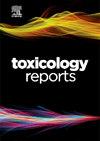人类可能食用的麻疯树籽油:其酚酯的毒理学评估。
Q1 Environmental Science
引用次数: 0
摘要
麻疯树种子以其高含油量而闻名,从这些种子中提取的油传统上用于生产生物柴油。麻疯树籽油(JCSO)中存在有毒化合物,特别是酚酯(PEs),阻碍了其用于人类消费。本文综述了麻疯树酚酯(JCPEs)的急性毒性、遗传毒性、致癌性和慢性毒性等毒理学效应的最新研究进展。它还提供了当前解毒策略的概述。采用基准剂量法(BMD)进行定量风险评估,得出JCPEs的急性参考剂量(ARfD)为139.64 μg kg-1体重(表示为12- o -十四烷醇-磷酸-13-乙酸当量)。此外,建立了亚慢性暴露环境下JCPEs的健康指导值(HBGV)为每天0.0105 mg kg-1体重。这些结果指导了JCSO脱毒目标的制定,目标是脱毒率达到99.5 %,并为进一步研究JCSO在食品中使用的可行性提供了建议。本文章由计算机程序翻译,如有差异,请以英文原文为准。
Jatropha curcas seed oil for possible human consumption: A toxicological assessment of its phorbol esters
Jatropha curcas seeds are known for their high oil content, and the oil extracted from these seeds has been traditionally utilized in biodiesel production. The presence of toxic compounds, specifically phorbol esters (PEs), in Jatropha curcas seed oil (JCSO) has blocked its use for human consumption. This article presents a thorough literature review that summarizes the latest research on the toxicological effects, including acute toxicity, genotoxicity, carcinogenicity, and chronic toxicity associated with Jatropha curcas phorbol esters (JCPEs). It also provides an overview of current detoxification strategies. A quantitative risk assessment was performed using the Benchmark Dose (BMD) approach, revealing an Acute Reference Dose (ARfD) of 139.64 μg kg−1 body weight for JCPEs (expressed as 12-O-tetradecanoyl-phorbol-13-acetate equivalent). Moreover, a Health-Based Guidance Value (HBGV) for JCPEs in a sub-chronic exposure context was established at 0.0105 mg kg−1 body weight per day. These results have guided the formulation of detoxification goals for JCSO, targeting a detoxification rate of 99.5 %, along with recommendations for future research to investigate the feasibility of using JCSO in food products.
求助全文
通过发布文献求助,成功后即可免费获取论文全文。
去求助
来源期刊

Toxicology Reports
Environmental Science-Health, Toxicology and Mutagenesis
CiteScore
7.60
自引率
0.00%
发文量
228
审稿时长
11 weeks
 求助内容:
求助内容: 应助结果提醒方式:
应助结果提醒方式:


